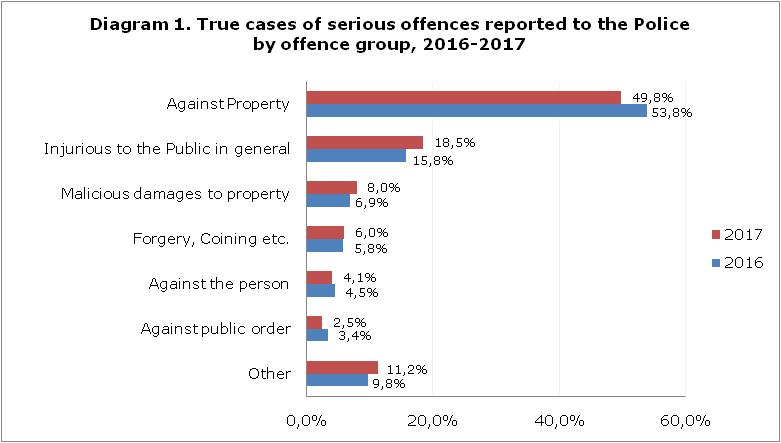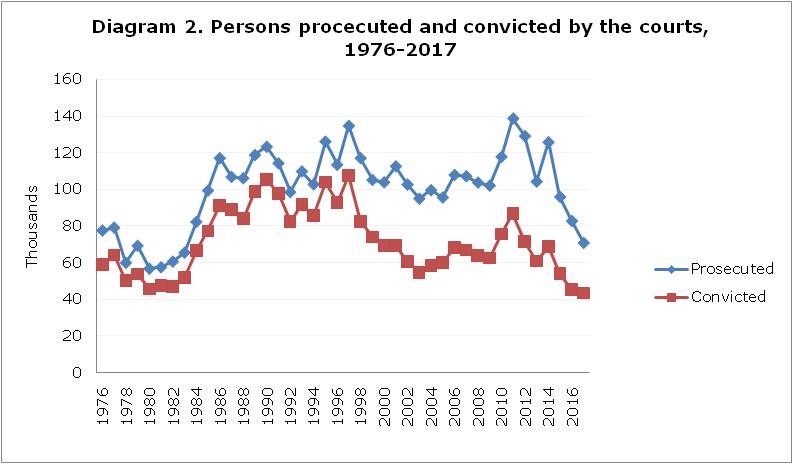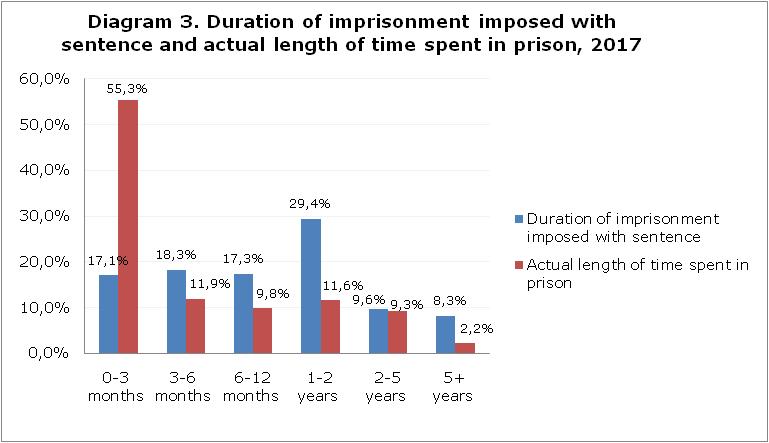Press Releases

12-06-2019 14:10
Latest figures: Criminal statistics 2016-2017
Police Statistics
Cases of Serious Offences
The number of serious offences reported to the Police in 2016 was 5.236, of which 5.215 were found to be true cases, while in 2017 the number of serious offences reported was 5.228, of which 5.173 were true cases. Both in 2016 and in 2017, the offences against property constitute the largest group of offences, accounting for 53,8% and 49,8% of serious offences respectively, followed by offences injurious to the public in general, accounting for 15,8% and 18,5% respectively. The index of crime per 100.000 inhabitants was calculated to be 614 in 2016 and 601 in 2017, compared to 702 in 2015.

Victims
In 5.215 true cases of serious offences in 2016, a total of 5.705 victims were recorded, 1.288 of which were legal entities. Of the 4.417 victims who were natural persons, 76,5% were Cypriots, 10,6% were EU-28 citizens, while 7,9% were citizens of non-EU countries. In 5.173 true cases recorded in 2017, a total of 5.373 victims were recorded, 1.468 of which were legal entities. Of the 3.905 victims who were natural persons, 77,7% were Cypriots, 9,7% were EU-28 citizens, while 7,7% were citizens of non-EU countries. In both years, about half of the victims which were legal entities were victims of the group of offences injurious to the public in general, while about two thirds of the victims who were natural persons were victims of offences against property.
Offenders (Total) involved in Serious Offences
A total of 5.040 offenders were involved in the commission of serious offences during 2016. Of the 5.033 who were natural persons, 572 were females (11,4%), reflecting the fact that the involvement of women in serious crime remains relatively small compared to that of men. The main offences committed by both females and males were offences against property, accounting for 37,2% of female offenders and 41,4% of male offenders. As regards the citizenship of offenders who were natural persons, 54,1% were Cypriots and 24,6% were EU-28 citizens. Similar results were recorded in 2017: a total of 5.071 offenders were involved in the commission of serious offences. Of the 5.039 who were natural persons, 9,3% were females, whereas 50,7% of the total were Cypriots and 28,7% were non-EU citizens. The main offences committed by both females and males were offences against property (31,6% and 37,6% respectively).
Juvenile Delinquency
During 2016, a total of 131 juveniles were involved in the commission of offences, 18 of which were girls, accounting for 13,7% of juvenile offenders. There were 99 juveniles involved in serious offences and 32 in minor offences. Concerning the citizenship of juvenile offenders involved in both serious and minor offences, 71,0% were Cypriots and 12,2% were EU-28 citizens. During 2017, a total of 107 juveniles were involved in the commission of offences, five of which were girls (4,7%). A total of 66 juveniles were involved in serious offences and 41 in minor offences. As regards the citizenship of juvenile offenders involved in both serious and minor offences, 81,3% were Cypriots and 11,2% were EU-28 citizens.
JUDICIAL STATISTICS
Penal Proceedings
During 2016, a total of 82.891 persons (66.261 males and 16.630 females) appeared before the courts charged with an offence and had their cases disposed of. The corresponding figures for 2017 were 70.960 (57.021 males and 13.939 females), recording a decrease of 14,4%. The ratio of the number of offenders convicted to the number of persons charged was calculated to be 0,55 in 2016 and 0,61 in 2017.

The share of females to the total number of persons prosecuted has gradually increased from 7,2% in 1976, to 15,1% in 1990 and 17,1% in 2010. In 2013, the corresponding percentage was 19,1%, in 2014 rose to 19,9%, in 2015 fell to 19,1%, while in 2016 it rose to 20,1% and in 2017 it reached 19,6%.
Convictions
The total number of persons convicted in 2017 reached 43.477, of which 34.752, or 79,9%, were males. In 2016, 45.324 persons were convicted, of whom 36.688 (or 80,9%) were males.
Offences
During 2017, the bulk of offences were motoring offences, accounting for 56,6% of males and 61,2% of females convicted. The corresponding figures for 2016 were: a share of 45,0% of the total number of males and a share of 45,7% of the total number of females were convicted of motoring offences as well.
Sentences
The type of sentence imposed varies with the nature and gravity of the offence committed and the individual need of the offender for appropriate treatment. Both in 2017 and in 2016, the most commonly used sentence by the courts was the imposition of fines, which occurred in 94,0% and 94,4% of convictions respectively.
PRISON STATISTICS
Prison Population
The prison population on the 1st of September 2017 was 625 persons, 589 males and 36 females, compared to 668 persons in 2016, 614 males and 54 females. The overwhelming majority of prisoners (96,5%) were 21 years of age or older, while 73,9% were convicted prisoners and 26,1% were prisoners awaiting trial. The Cypriot prisoners amounted to 60,0% of the total. The corresponding figures for 2016 were 614 males, corresponding to 91,9% of the total prison population which had reached 668 persons on the 1st of September 2016. The prisoners who were 21 years of age or older constituted 96,7% of the total, the Cypriot prisoners 58,2% and the convicted prisoners 70,5%.
Admissions of Convicted Prisoners
During 2017, the admissions of convicted prisoners numbered 727 (647 males and 80 females), of whom 505 males and 74 females had been convicted of criminal offences by the criminal courts and the martial court. The corresponding figures for 2016 were 759 admissions (652 males and 107 females), of whom 476 males and 93 females had been convicted of criminal offences. The rest had been convicted of offences against the military criminal code, or where non-criminal prisoners, i.e. civil debtors or fine defaulters. The rate of sentenced prisoners per 100.000 inhabitants aged 16 and over was 102 in 2017, compared to 108 in 2016. The corresponding rate for penal offenders was 81 both in 2017 and in 2016.
Time Spent n Prison
Most of the sentences imposed in 2017 were of duration shorter than 12 months, thus resulting in a median length of sentence of 10,9 months compared to 12,3 months in 2016. The actual period of time spent in prison, however, is generally shorter than that imposed with the sentence, being reduced to a large extent by the use of remission. Consequently, the median length of stay in prison for the total number of convicted prisoners, computed based on the releases of 2017, was 2,6 months compared to 2,7 months in 2016.

Prison Recidivism
Of the total number of admitted prisoners in 2017, the majority, accounting for over 85%, did not have a previous custodial sentence. Of those who had served at least one custodial sentence in the past, approximately one in two had been readmitted to prison within a period shorter than 12 months from their last release from prison. Furthermore, more than 50% had been convicted for the same offence group as in their previous custodial sentence.
METHODOLOGICAL NOTES:
Survey Characteristics
The survey aims at examining the overall crime situation in the country and covers three main branches: Police, Judicial and Prison statistics. According to the Police Statistics, the analysis is based on offences recognised as such by the criminal law and covers only serious offences reported to the Police which have been committed by adults, as well as all offences (serious and minor) committed by young persons (aged 14 years or older and younger than 16 years). As regards Judicial Statistics, the data refers to the year during which the penal proceedings at the courts were completed, that is, the year during which the prosecution of the suspects to the courts and the indictment took place. The year in question is not necessarily the year during which the offence was committed. Concerning Prison Statistics, the analysis covers both convicted prisoners and prisoners awaiting trial.
ThePoliceStatisticsfiguresfortheyear2017 are provisional.
Definitions
SeriousOffences: Indictable offences, attempts or omissions, determined according to the Criminal Law of the country.
IndexofCrime: The ratio of the number of true cases of serious offences reported to the Police per 100.000 inhabitants.
Coverage and Data Collection
The survey in question is based on data from three sources: the Police, the Courts and the Prison Institution. The first branch, “Police Statistics” is comprised of the sections “Cases”, “Offenders” and “Victims” and is based on administrative data acquired from the Police.
In the section “Cases”, the analysis concerns cases of serious offences reported to the Police and more specifically, detailed data relating to the time, place and manner in which the offence was committed, as well as the offence group or the individual offences in detail. The basic statistical unit is the case recorded. It is noted that, in many cases, more than one offence is reported, however only the most serious offence is recorded, according to the Principal Offence Rule.
In the section “Victims”, the analysis pertains to victims (both legal entities and natural persons), of the cases of serious offences reported to the Police, such as data on the age, gender and citizenship of the victims (natural persons), as well as the relationship between the victim and the perpetrator. The basic statistical unit is the victim.
In the section “Offenders”, the analysis concerns the total number of offenders, both legal entities and natural persons. As regards natural persons, it covers adults involved in the commission of serious offences, as well as juvenile offenders involved both in serious as well as minor offences. What may constitute a criminal act if committed by an adult may not be considered as such if committed by a child, since this is determined by the age of criminal responsibility, according to the country’s legal framework. An offender who is involved in a serious offence more than once (on separate occasions) in one year, is counted as two or more persons, i.e. s/he is counted as a different offender in each separate case. Data is presented, inter alia, on the age, gender and citizenship of offenders who are natural persons. The basic statistical unit is the offender involved.
In the second branch, “JudicialStatistics”, data is presented on criminal judicial statistics. It is based on annual returns of criminal proceedings submitted at the end of the year by the District Courts, the Assize Courts and the Martial Court and it covers both adult and juvenile offenders. The basic statistical unit is the “occasion” on which proceedings against a person are completed.
The third branch titled “PrisonStatistics” presents data based on monthly and quarterly reports of the Prison Institution. The basic statistical unit is the prisoner.
For more information:
Statistical Service (CYSTAT) Website, sub-theme Crime
Contact:
Georgia Ioannou: Tel.: +35722602144, Email: gioannou@cystat.mof.gov.cy
(MG/II)
Relevant Press Releases



18-11-2024 14:15
Price Index of Construction Materials: October 2024

15-11-2024 15:12
Road Freight Transport: 2nd Quarter 2024

14-11-2024 13:52
GDP Growth Rate: 3rd quarter 2024 (Flash Estimate)


